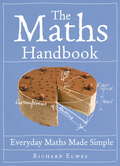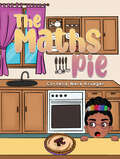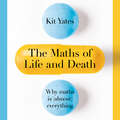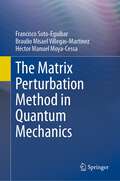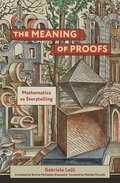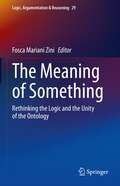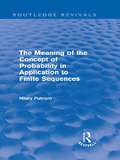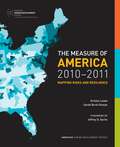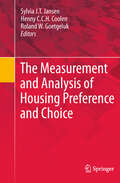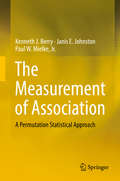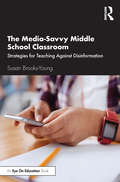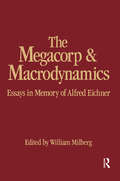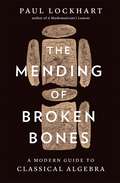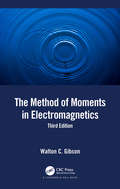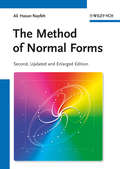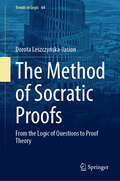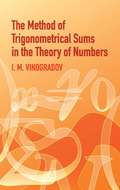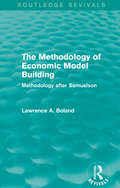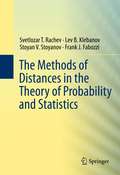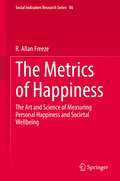- Table View
- List View
The Maths Handbook: Everyday Maths Made Simple
by Richard ElwesThis is the perfect introduction for those who have a lingering fear of maths. If you think that maths is difficult, confusing, dull or just plain scary, then The Maths Handbook is your ideal companion. Covering all the basics including fractions, equations, primes, squares and square roots, geometry and fractals, Dr Richard Elwes will lead you gently towards a greater understanding of this fascinating subject. Even apparently daunting concepts are explained simply, with the assistance of useful diagrams, and with a refreshing lack of jargon.So whether you're an adult or a student, whether you like Sudoku but hate doing sums, or whether you've always been daunted by numbers at work, school or in everyday life, you won't find a better way of overcoming your nervousness about numbers and learning to enjoy making the most of mathematics.
The Maths Handbook: Everyday Maths Made Simple
by Richard ElwesThis is the perfect introduction for those who have a lingering fear of maths. If you think that maths is difficult, confusing, dull or just plain scary, then The Maths Handbook is your ideal companion. Covering all the basics including fractions, equations, primes, squares and square roots, geometry and fractals, Dr Richard Elwes will lead you gently towards a greater understanding of this fascinating subject. Even apparently daunting concepts are explained simply, with the assistance of useful diagrams, and with a refreshing lack of jargon.So whether you're an adult or a student, whether you like Sudoku but hate doing sums, or whether you've always been daunted by numbers at work, school or in everyday life, you won't find a better way of overcoming your nervousness about numbers and learning to enjoy making the most of mathematics.
The Maths Pie
by Cornelia Wera KruegerMaths sometimes looks scary, but it isn’t! Trust me, you’ve got this! Maths in primary school isn’t easy for everyone, especially Imani. For Imani it is just frustrating, scary, and a book with seven seals. In order to help Imani, her mother comes up with a brilliant and yummy idea, The Maths Pie, to take her daughter’s fear of maths away, and show her that is actually isn’t that bad and can even be quite easy. Read through till the end, as there is a surprise waiting for you. By the way: I, the author of this book, had a fear of maths, so rest assured you’re not alone in this.
The Maths of Life and Death
by Kit Yates*SELECTED AS ONE OF THE SUNDAY TIMES SCIENCE BOOKS OF THE YEAR* "This is an exquisitely interesting book. It's a deeply serious one too and, for those like me who have little maths, it's delightfully readable" - IAN MCEWAN"An exciting new voice in the world of science communication" - MARCUS DU SAUTOY"An extremely thoughtful, articulate and accessible insight into mathematics in the real world" - ALEX BELLOS"Kit Yates is a brilliant explainer and storyteller" - STEVEN STROGATZ__________Maths is the story of the world around us, and the wisdom it gives us can be the difference between success and disaster.We are all doing maths all the time, from the way we communicate with each other to the way we travel, from how we work to how we relax. Many of us are aware of this. But few of us really appreciate the full power of maths - the extent to which its influence is not only in every office and every home, but also in every courtroom and hospital ward.In this eye-opening and extraordinary book, Yates explores the true stories of life-changing events in which the application - or misapplication - of mathematics has played a critical role: patients crippled by faulty genes and entrepreneurs bankrupted by faulty algorithms; innocent victims of miscarriages of justice and the unwitting victims of software glitches. We follow stories of investors who have lost fortunes and parents who have lost children, all because of mathematical misunderstandings.Along the way, Yates arms us with simple mathematical rules and tools that can help us make better decisions in our increasingly quantitative society. You will discover why it's always sensible to question a statistic, often vital to ask for a second opinion and sometimes surprisingly handy to stick to the 37% rule...
The Maths of Life and Death
by Kit YatesMaths is the story of the world around us, and the wisdom it gives us can be the difference between success and disaster.We are all doing maths all the time, from the way we communicate with each other to the way we travel, from how we work to how we relax. Many of us are aware of this. But few of us really appreciate the full power of maths - the extent to which its influence is not only in every office and every home, but also in every courtroom and hospital ward.In this eye-opening and extraordinary book, Yates explores the true stories of life-changing events in which the application - or misapplication - of mathematics has played a critical role: patients crippled by faulty genes and entrepreneurs bankrupted by faulty algorithms; innocent victims of miscarriages of justice and the unwitting victims of software glitches. We follow stories of investors who have lost fortunes and parents who have lost children, all because of mathematical misunderstandings.Along the way, Yates arms us with simple mathematical rules and tools that can help us make better decisions in our increasingly quantitative society. You will discover why it's always sensible to question a statistic, often vital to ask for a second opinion and sometimes surprisingly handy to stick to the 37% rule...(P)2019 Quercus Editions Limited
The Matrix Perturbation Method in Quantum Mechanics
by Francisco Soto-Eguibar Braulio Misael Villegas-Martínez Héctor Manuel Moya-CessaThis book provides an alternative approach to time-independent perturbation theory in non-relativistic quantum mechanics. It allows easy application to any initial condition because it is based on an approximation to the evolution operator and may also be used on unitary evolution operators for the unperturbed Hamiltonian in the case where the eigenvalues cannot be found. This flexibility sets it apart from conventional perturbation theory. The matrix perturbation method also gives new theoretical insights; for example, it provides corrections to the energy and wave function in one operation. Another notable highlight is the facility to readily derive a general expression for the normalization constant at m-th order, a significant difference between the approach within and those already in the literature. Another unique aspect of the matrix perturbation method is that it can be extended directly to the Lindblad master equation. The first and second-order corrections are obtained for this equation and the method is generalized for higher orders. An alternative form of the Dyson series, in matrix form instead of integral form, is also obtained. Throughout the book, several benchmark examples and practical applications underscore the potential, accuracy and good performance of this novel approach. Moreover, the method's applicability extends to some specific time-dependent Hamiltonians. This book represents a valuable addition to the literature on perturbation theory in quantum mechanics and is accessible to students and researchers alike.
The Maximal Subgroups of the Low-Dimensional Finite Classical Groups
by John N. Bray Derek F. Holt Colva M. Roney-DougalThis book classifies the maximal subgroups of the almost simple finite classical groups in dimension up to 12; it also describes the maximal subgroups of the almost simple finite exceptional groups with socle one of Sz(q), G2(q), 2G2(q) or 3D4(q). Theoretical and computational tools are used throughout, with downloadable Magma code provided. The exposition contains a wealth of information on the structure and action of the geometric subgroups of classical groups, but the reader will also encounter methods for analysing the structure and maximality of almost simple subgroups of almost simple groups. Additionally, this book contains detailed information on using Magma to calculate with representations over number fields and finite fields. Featured within are previously unseen results and over 80 tables describing the maximal subgroups, making this volume an essential reference for researchers. It also functions as a graduate-level textbook on finite simple groups, computational group theory and representation theory.
The Meaning of Proofs: Mathematics as Storytelling
by Gabriele LolliWhy mathematics is not merely formulaic: an argument that to write a mathematical proof is tantamount to inventing a story.In The Meaning of Proofs, mathematician Gabriele Lolli argues that to write a mathematical proof is tantamount to inventing a story. Lolli offers not instructions for how to write mathematical proofs, but a philosophical and poetic reflection on mathematical proofs as narrative. Mathematics, imprisoned within its symbols and images, Lolli writes, says nothing if its meaning is not narrated in a story. The minute mathematicians open their mouths to explain something—the meaning of x, how to find y—they are framing a narrative. Every proof is the story of an adventure, writes Lolli, a journey into an unknown land to open a new, connected route; once the road is open, we correct it, expand it. Just as fairy tales offer a narrative structure in which new characters can be inserted into recurring forms of the genre in original ways, in mathematics, each new abstract concept is the protagonist of a different theory supported by the general techniques of mathematical reasoning. In ancient Greece, there was more than an analogy between literature and mathematics, there was direct influence. Euclid&’s proofs have roots in poetry and rhetoric. Mathematics, Lolli asserts, is not the mere manipulation of formulas.
The Meaning of Something: Rethinking the Logic and the Unity of the Ontology (Logic, Argumentation & Reasoning #29)
by Fosca Mariani ZiniThis innovative volume investigates the meaning of ‘something’ in different recent philosophical traditions in order to rethink the logic and the unity of ontology, without forgetting to compare these views to earlier significative accounts in the history of philosophy. In fact, the revival of interest in “something” in the 19th and 20th centuries as well as in contemporary philosophy can easily be accounted for: it affords the possibility for asking the question: what is there? without engaging in predefined speculative assumptions The issue about “something” seems to avoid any naive approach to the question about what there is, so that it is treated in two main contemporary philosophical trends: “material ontology”, which aims at taking “inventory” of what there is, of everything that is; and “formal ontology”, which analyses the structural features of all there is, whatever it is. The volume advances cutting-edge debates on what is the first et the most general item in ontology, that is to say “something”, because the relevant features of the conceptual core of something are: non-nothingness, otherness. Something means that one being is different from others. The relationality belongs to something.: Therefore, the volume advances cutting-edge debates in phenomenology, analytic philosophy, formal and material ontology, traditional metaphysics.
The Meaning of the Concept of Probability in Application to Finite Sequences (Routledge Revivals)
by Hilary PutnamFirst published in 1990, this is a reissue of Professor Hilary Putnam’s dissertation thesis, written in 1951, which concerns itself with The Meaning of the Concept of Probability in Application to Finite Sequences and the problems of the deductive justification for induction. Written under the direction of Putnam’s mentor, Hans Reichenbach, the book considers Reichenbach’s idealization of very long finite sequences as infinite sequences and the bearing this has upon Reichenbach’s pragmatic vindication of induction.
The Measure of America, 2010-2011: Mapping Risks and Resilience (Social Science Research Council #9)
by Kristen Lewis Sarah Burd-SharpsThe Measure of America, 2010-2011, is the definitive report on the overall well-being of all Americans. How are Americans doing—compared to one another and compared to the rest of the world? This important, easy-to-understand guide will provide all of the essential information on the current state of America.This fully illustrated report, with over 130 color images, is based on the groundbreaking American Human Development Index, which provides a single measure of the well-being for all Americans, disaggregated by state and congressional district, as well as by race, gender, and ethnicity. The Index rankings of the 50 states and 435 congressional districts reveal huge disparities in the health, education, and living standards of different groups. For example, overall, Connecticut ranked first among states on the 2008-2009 Index, and Mississippi ranked last, suggesting that there is a 30-year gap in human development between the two states. Further, among congressional districts, New York’s 14th District, in Manhattan, ranked first, and California’s 20th District, near Fresno, ranked last. The average resident of New York’s 14th District earned over three times as much as the average resident of California’s 20th District, lived over four years longer, and was ten times as likely to have a college degree.The second in the American Human Development Report series, the 2010-2011 edition features a completely updated Index, new findings on the well-being of different racial and ethnic groups from state to state, and a closer look at disparities within major metro areas. It also shines a spotlight on threats to progress and opportunity for some Americans as well as highlighting tested approaches to fosteringresilience among different groups.Using a revelatory framework for explaining the very nature of humanprogress, this report can be used not only as a way to measure America but also to build upon past policy successes, protect the progress made over the last half century from new risks, and create an infrastructure of opportunity that can serve a new generation of Americans. Beautifully illustrated with stunning four-color graphics that allow for a quick visual understanding of often complex but important issues, The Measure of America is essential reading for all Americans, especially for social scientists, policy makers, and pundits who want to understand where Americans stand today.
The Measure of Economies: Measuring Productivity in an Age of Technological Change
by Marshall B. Reinsdorf Louise SheinerInnovative new approaches for improving GDP measurement to better gauge economic productivity. Official measures of gross domestic product (GDP) indicate that productivity growth has declined in the United States over the last two decades. This has led to calls for policy changes from pro-business tax reform to stronger antitrust measures. But are our twentieth-century economic methods actually measuring our twenty-first-century productivity? The Measure of Economies offers a synthesis of the state of knowledge in productivity measurement at a time when many question the accuracy and scope of GDP. With chapters authored by leading economic experts on topics such as the digital economy, health care, and the environment, it highlights the inadequacies of current practices and discusses cutting-edge alternatives. Pragmatic and forward-facing, The Measure of Economies is an essential resource not only for social scientists, but also for policymakers and business leaders seeking to understand the complexities of economic growth in a time of rapidly evolving technology.
The Measurement and Analysis of Housing Preference and Choice
by Henny C.C.H. Coolen Sylvia J.T. Jansen Roland W. GoetgelukWhat are the current trends in housing? Is my planned project commercially viable? What should be my marketing and advertisement strategies? These are just some of the questions real estate agents, landlords and developers ask researchers to answer. But to find the answers, researchers are faced with a wide variety of methods that measure housing preferences and choices. To select and value a valid research method, one needs a well-structured overview of the methods that are used in housing preference and housing choice research. This comprehensive introduction to this field offers just such an overview. It discusses and compares numerous methods, detailing the potential limitation of each one, and it reaches beyond methodology, illustrating how thoughtful consideration of methods and techniques in research can help researchers and other professionals to deliver products and services that are more in line with residents' needs.
The Measurement of Association: A Permutation Statistical Approach
by Kenneth J. Berry Janis E. Johnston Paul W. Mielke<p>This research monograph utilizes exact and Monte Carlo permutation statistical methods to generate probability values and measures of effect size for a variety of measures of association. Association is broadly defined to include measures of correlation for two interval-level variables, measures of association for two nominal-level variables or two ordinal-level variables, and measures of agreement for two nominal-level or two ordinal-level variables. Additionally, measures of association for mixtures of the three levels of measurement are considered: nominal-ordinal, nominal-interval, and ordinal-interval measures. Numerous comparisons of permutation and classical statistical methods are presented. <p>Unlike classical statistical methods, permutation statistical methods do not rely on theoretical distributions, avoid the usual assumptions of normality and homogeneity of variance, and depend only on the data at hand. This book takes a unique approach to explaining statistics by integrating a large variety of statistical methods, and establishing the rigor of a topic that to many may seem to be a nascent field. This topic is relatively new in that it took modern computing power to make permutation methods available to those working in mainstream research. <p>Written for a statistically informed audience, it is particularly useful for teachers of statistics, practicing statisticians, applied statisticians, and quantitative graduate students in fields such as psychology, medical research, epidemiology, public health, and biology. It can also serve as a textbook in graduate courses in subjects like statistics, psychology, and biology.</p>
The Media-Savvy Middle School Classroom: Strategies for Teaching Against Disinformation
by Susan Brooks-YoungThe Media-Savvy Middle School Classroom is a practical guide for teachers of Grades 5-8 who want to help their students achieve mastery of media literacy skills. Today’s fake news, alternative facts, and digital manipulations are compromising the critical thinking and well-being of middle grade learners already going through significant personal changes. This actionable book prepares teachers to help their students become informed consumers of online resources. Spanning correct source use, personal versus expert opinions, deliberate disinformation, social media, and more, these ready-to-use activities can be integrated directly into existing language arts and mathematics lesson plans.
The Megacorp and Macrodynamics: Essays in Memory of Alfred Eichner
by William MilbergThese essays on Post-Keynesian economics were written expressly for a volume to honour the life and work of Alfred Eichner. The original countributions - that critically examine and extend ideas in Eichner's "The Macrodynamics of Advanced Market Economies" are organized in seven sections that correspond to areas of economics in which Eichner made a significant contribution. Part 1 deals with the megacorp, a theory of firm pricing and investment that was one of Eichner's most important contributions. Issues of productivity and technical change, that lie at the center of Eichner's macrodynamic model, are the focus of part 1 and parts 3 and 4 elaborate on Eichner's work on growth and money and yield insights into the theoretical disagreements among the Post-Keynesians themselves. Part 5 presents a number of examples of non-neo-classical model building. Part 6 opens with a critique of the "new economic history" that leads to other essays on thorny methodological issues confronting Post-Keynesians. Part 7 gives a European perspective on North American Post-Keynesian economics. The essays reveal the relationships between Eichner's work and Institutionalist and Marxian economics. At the same time, the book raises current theoretical conflicts among these groups as well as among Post-Keynesians themselves. This book compliments Alfred S.Eichner's "The Macrodynamics of Advanced Market Economies", also published in 1991, and is appropriate for scholars and upper-level undergraduates and graduate students.
The Mending of Broken Bones: A Modern Guide to Classical Algebra
by Paul LockhartA joyful and intimate celebration of the beauty and creativity of algebra from one of the foremost math educators of our time.For many of us, algebra conjures up memories of dull classes spent wondering when we’d ever have to solve a system of equations or factor a polynomial. Indeed, most of the time, if we need to plan a budget or figure out how early to leave the house for work, common sense or a quick, seat-of-the-pants approximation is good enough.But as mathematician Paul Lockhart argues in The Mending of Broken Bones, once we stop thinking of algebra in terms of its practical applications, we can appreciate it for the beautiful and gratifying subject that it is. In his hands, algebra is the delicate craft of untangling numerical puzzles to reveal the hidden patterns and often surprising behaviors of the numbers themselves. As Lockhart traverses numerical systems, slips into and out of higher-dimensional space, and delights in the intimate connections between algebra and geometry, we come to see the discipline from his viewpoint: not as the mundane exercises of our school years, but instead as an art form whose beauty lies in its elegant simplicity.Written in Lockhart’s charming and conversational prose, The Mending of Broken Bones is an impassioned and deeply personal celebration of algebra that helps us experience the profound joys of mathematical discovery.
The Method of Moments in Electromagnetics
by Walton C. GibsonThe Method of Moments in Electromagnetics, Third Edition details the numerical solution of electromagnetic integral equations via the Method of Moments (MoM). Previous editions focused on the solution of radiation and scattering problems involving conducting, dielectric, and composite objects. This new edition adds a significant amount of material on new, state-of-the art compressive techniques. Included are new chapters on the Adaptive Cross Approximation (ACA) and Multi-Level Adaptive Cross Approximation (MLACA), advanced algorithms that permit a direct solution of the MoM linear system via LU decomposition in compressed form. Significant attention is paid to parallel software implementation of these methods on traditional central processing units (CPUs) as well as new, high performance graphics processing units (GPUs). Existing material on the Fast Multipole Method (FMM) and Multi-Level Fast Multipole Algorithm (MLFMA) is also updated, blending in elements of the ACA algorithm to further reduce their memory demands. The Method of Moments in Electromagnetics is intended for students, researchers, and industry experts working in the area of computational electromagnetics (CEM) and the MoM. Providing a bridge between theory and software implementation, the book incorporates significant background material, while presenting practical, nuts-and-bolts implementation details. It first derives a generalized set of surface integral equations used to treat electromagnetic radiation and scattering problems, for objects comprising conducting and dielectric regions. Subsequent chapters apply these integral equations for progressively more difficult problems such as thin wires, bodies of revolution, and two- and three-dimensional bodies. Radiation and scattering problems of many different types are considered, with numerical results compared against analytical theory as well as measurements.
The Method of Normal Forms
by Ali H. NayfehIn this introductory treatment Ali Nayfeh presents different concepts from dynamical systems theory and nonlinear dynamics in a rigorous yet plan way. He systematically introduces models and techniques and states the relevant ranges of validity and applicability. The reader is provided with a clear operational framework for consciously use rather than focused on the underlying mathematical apparatus. The exposition is largely by means of examples, dealt with up to their final outcome. For most of the examples, the results obtained with the method of normal forms are equivalent to those obtained with other perturbation methods, such as the method of multiple scales and the method of averaging. The previous edition had a remarkable success by researchers from all over the world working in the area of nonlinear dynamics and their applications in engineering. Additions to this new edition concern major topics of current interest. In particular, the author added three new chapters dedicated to Maps, Bifurcations of Continuous Systems, and Retarded Systems. In particular the latter has become of major importance in several applications, both in mechanics and in different areas. Accessible to engineers and applied scientist involved with nonlinear dynamics and their applications in a wide variety of fields. It is assumed that readers have a knowledge of basic calculus as well as the elementary properties of ordinary-differential equations.
The Method of Socratic Proofs: From the Logic of Questions to Proof Theory (Trends in Logic #64)
by Dorota Leszczyńska-JasionThis book contains a systematic and formal attempt to model solutions to problems such as: Is it possible to prove a question? Is it possible to prove something by the use of questions? Do the existing paradigms in the logic of questions allow one to combine questions and proofs? What are the results in this field? In developing answers, the book focuses on the applications of the method of Socratic proofs, and goes beyond that. It starts out with an overview of the leading paradigms, issues, problems and ready solutions in the logic of questions, and places Inferential Erotetic Logic and the method of Socratic proofs against a wider background. It then introduces these two methods in more detail and explains how they can be used for classical logic, intuitionistic propositional logic and for basic modal logics. Next, the book deals with issues specific to the field of the logic of questions, introducing the tools of Minimal Erotetic Semantics (MiES). The final chapters describe the translations between proof systems: from a Socratic transformation, derived in an erotetic calculus, into a sequent system.
The Method of Trigonometrical Sums in the Theory of Numbers (Dover Books on Mathematics)
by I. M. VinogradovSince the 1930s, the analytic theory of numbers has been transformed by the influence of I. M. Vinogradov, and this text for upper-level undergraduates and graduate students testifies to its author's ingenuity and to the effectiveness of his methods. Starting with a discussion of general lemmas, it advances to an investigation of Waring's problem, including explorations of singular series, the contribution of the basic intervals, and an estimate for G(n). Further topics include approximation by the fractional parts of the values of a polynomial, estimates for Weyl sums, the asymptotic formula in Waring's problem, the distribution of the fractional parts of the values of a polynomial, estimates for the simplest trigonometrical sums with primes, and Goldbach's problem. 1954 edition.
The Methodology of Economic Model Building: Methodology after Samuelson (Routledge Revivals)
by Lawrence A. BolandThe major methodological task for modern economists has been to establish the testability of models. Too often, however, methodological assumptions can make a model virtually impossible to test even under ideal conditions, yet few theorists have examined the requirements and problems of assuring testability in economics. In The Methodology of Economic Model Building, first published in 1989, Lawrence Boland presents the results of a research project that spanned more than twenty years. He examines how economists have applied the philosophy of Karl Popper, relating methodological debates about falsifiability to wider discussions about the truth status of models in natural and social sciences. He concludes that model building in economics reflects more the methodological prescriptions of the economist Paul Samuelson than Popper’s ‘falsificationism’. This title will prove invaluable to both students and researchers, and represents a substantial contribution to debates about the scientific status of economics.
The Methods of Distances in the Theory of Probability and Statistics
by Lev Klebanov Svetlozar T. Rachev Stoyan V. Stoyanov Frank FabozziThis book covers the method of metric distances and its application in probability theory and other fields. The method is fundamental in the study of limit theorems and generally in assessing the quality of approximations to a given probabilistic model. The method of metric distances is developed to study stability problems and reduces to the selection of an ideal or the most appropriate metric for the problem under consideration and a comparison of probability metrics. After describing the basic structure of probability metrics and providing an analysis of the topologies in the space of probability measures generated by different types of probability metrics, the authors study stability problems by providing a characterization of the ideal metrics for a given problem and investigating the main relationships between different types of probability metrics. The presentation is provided in a general form, although specific cases are considered as they arise in the process of finding supplementary bounds or in applications to important special cases. Svetlozar T. Rachev is the Frey Family Foundation Chair of Quantitative Finance, Department of Applied Mathematics and Statistics, SUNY-Stony Brook and Chief Scientist of Finanlytica, USA. Lev B. Klebanov is a Professor in the Department of Probability and Mathematical Statistics, Charles University, Prague, Czech Republic. Stoyan V. Stoyanov is a Professor at EDHEC Business School and Head of Research, EDHEC-Risk Institute--Asia (Singapore). Frank J. Fabozzi is a Professor at EDHEC Business School. (USA)
The Metrics of Happiness: The Art and Science of Measuring Personal Happiness and Societal Wellbeing (Social Indicators Research Series #86)
by R. Allan FreezeThis book provides a comprehensive treatment of how happiness and wellbeing are measured. It presents an accessible summary of the philosophy, methodology, and applicability of the various measurement techniques that have been generated by the leaders of the happiness movement. It traces the history of development of the core ideas, and clarifies the unexpectedly wide range of techniques that are used. The book provides an unbiased assessment of the strengths and weaknesses of each approach and differentiates the contributions that have been made by psychologists, economists, environmentalists, and health scientists. It examines applications at a personal scale, in the workplace, at a societal scale, and on the world stage. It does so in an easy-to-read anecdotal writing style that will appeal to a wide range of academic and lay readers who enjoy popularized non-fiction that address matters of social concern.
The Millennial Generation: Implications for the Intelligence and Policy Communities
by Cortney Weinbaum Jenny Oberholtzer Richard S. GirvenIn 2015, for the first time, millennials outnumbered baby boomers as the largest generational segment of the U.S. population. This report describes how the intelligence community must engage millennials across multiple segments to succeed in the future: millennials as intelligence clients, employees, and partners and as members of the public.
